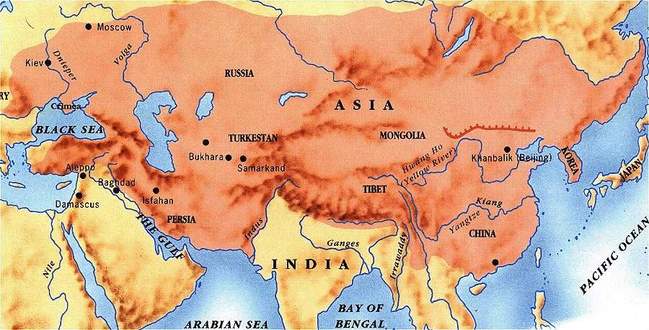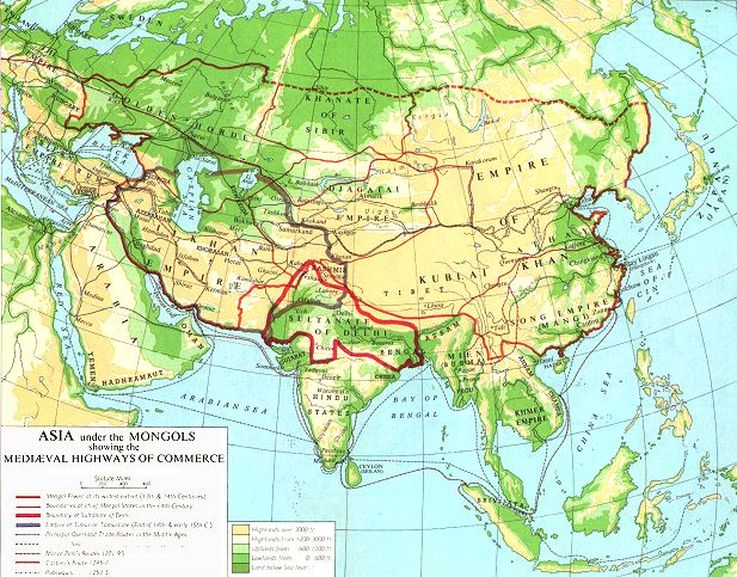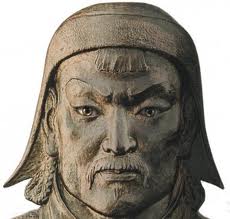The Mongol Empire
How the Mongol Invasion Impacted China:
The Mongols were nomadic people (located in Central Asia) that warred with one another until a brilliant leader named Genghiz Khan took over, united the warring tribes, and conquered a vast empire that stretched from the Pacific Ocean to Eastern Europe.
The Mongols made their way easily through the all Asia, but faced a problem when they came to conquer China- the Great Wall of China was in their way. With the help of Chinese and Turkish military leaders, the Mongols learned how to use cannons and other new weapons. That way, the Mongols and Chinese launched missiles at each other. For a long time, the Mongols were still unable to conquer China. However, 150 years later, they did it! Their empire finally reached China; and they did it in a very oppressive way. The Mongols devastated the province of Sichuan and annihilated its capital city of Chengdu. Once they had control over China, however, the Mongols didn' t treat the Chinese people as bad as many people would've thought. They ruled the land with toleration, justice, and respect. The rulers established peace and order within the empires during the period that is now known as the Pax Mongolica. With this came political stability and great economic growth. Under their protection, the silk road brought trade to the empires. Cultural exchanges were also being seen at the time, as ideas moved along trade routes.
Genghis Khan was only able to conquer Northern China. Over the years, however, Genghiz Khan's grandson Kublai was finally able to conquer all China. However, there was one odd thing about this new emperor. Genghis Khan was so scared that the Mongols would be absorbed by Chinese civilization that he only allowed Mongols to serve in the military and reserved the highest government jobs for the Mongols only. Yet, he adopted a Chinese name for the dynasty, extended the Grand Canal to his capital, and allowed foreigners to his court.
The Mongols made their way easily through the all Asia, but faced a problem when they came to conquer China- the Great Wall of China was in their way. With the help of Chinese and Turkish military leaders, the Mongols learned how to use cannons and other new weapons. That way, the Mongols and Chinese launched missiles at each other. For a long time, the Mongols were still unable to conquer China. However, 150 years later, they did it! Their empire finally reached China; and they did it in a very oppressive way. The Mongols devastated the province of Sichuan and annihilated its capital city of Chengdu. Once they had control over China, however, the Mongols didn' t treat the Chinese people as bad as many people would've thought. They ruled the land with toleration, justice, and respect. The rulers established peace and order within the empires during the period that is now known as the Pax Mongolica. With this came political stability and great economic growth. Under their protection, the silk road brought trade to the empires. Cultural exchanges were also being seen at the time, as ideas moved along trade routes.
Genghis Khan was only able to conquer Northern China. Over the years, however, Genghiz Khan's grandson Kublai was finally able to conquer all China. However, there was one odd thing about this new emperor. Genghis Khan was so scared that the Mongols would be absorbed by Chinese civilization that he only allowed Mongols to serve in the military and reserved the highest government jobs for the Mongols only. Yet, he adopted a Chinese name for the dynasty, extended the Grand Canal to his capital, and allowed foreigners to his court.
The Ming Dynasty
After the death of Kublai Khan, the Chinese didn't want to put up with more foreign Mongol rulers anymore. Heavy taxes, corruption, and natural disasters led to many uprisings, one of which will change the history of China for eternity. This was the uprising Zhu Yuanzhang, a peasant leader, lead. He created a rebel army that pushed the Mongols back beyond the Great Wall. Zhu later founded a new Chinese dynasty and called it the Ming Dynasty.
The Ming: restored the civil service system, made confucian learning the 'road to success', created a board of censors that watched over the bureaucracy, and made even harder civil service exams.
Achievements:
- The peasants produced huge rice crops
-Better methods of fertilizing helped improve farming
-New crops were being traded between China and America
-Industries for porcelain, paper, and tools developed
-Repaired the canal system
-New technologies helped in manufacturing
-Created brilliant blue and white porcelain
-Developed their own styles of landscape painting
-Produced classical poetry
-Composed novels
-Produced the world's first detective stories
-Developed Chinese Opera
The Ming: restored the civil service system, made confucian learning the 'road to success', created a board of censors that watched over the bureaucracy, and made even harder civil service exams.
Achievements:
- The peasants produced huge rice crops
-Better methods of fertilizing helped improve farming
-New crops were being traded between China and America
-Industries for porcelain, paper, and tools developed
-Repaired the canal system
-New technologies helped in manufacturing
-Created brilliant blue and white porcelain
-Developed their own styles of landscape painting
-Produced classical poetry
-Composed novels
-Produced the world's first detective stories
-Developed Chinese Opera



